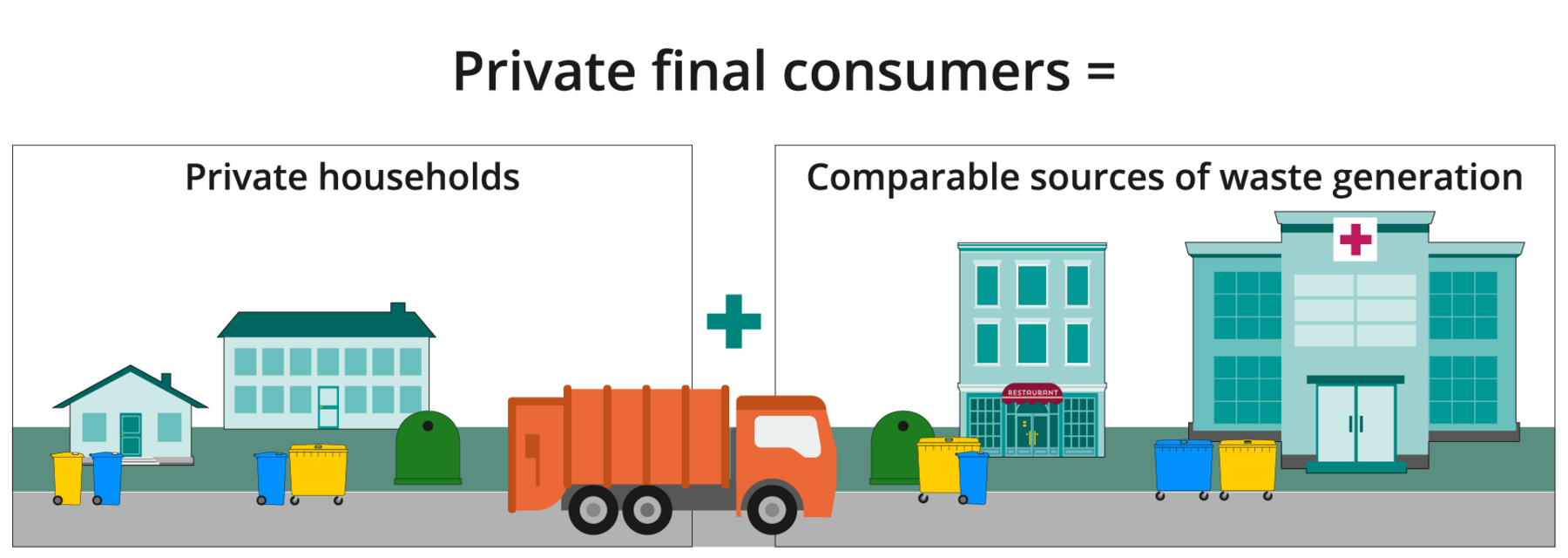System participation requirement: using the catalogue data base to verify compliance
You have to register with the LUCID Packaging Register because you are handing over packaged goods to customers. Retail, grouped or shipment packaging typically accumulates as waste with private final consumers. You are required to pay for the recycling of that packaging. This is called 'system participation'. Search our catalogue database for your products to find out if their packaging is subject to system participation.
What does 'typically' mean?
Who is a private final consumer?
The Verpackungsgesetz (Packaging Act) defines private final consumers as private households and comparable sources of waste generation such as restaurants, hotels, hospitals, canteens, amusement parks, garden centres, laundries, libraries and schools. Comparable sources of waste generation also include craft enterprises and agricultural holdings where packaging waste is collected at the rate that is normally associated with private households, i.e. at 14-day intervals and in a waste bin that does not exceed 1,100 litres per collection group. A list of comparable sources of waste generation can be found here.
Help on using the catalogue
Guidelines
The guidelines can help you use the system participation requirement catalogue as an administrative regulation. They also include further information about the structure and legal background of the catalogue as well as answers to frequently asked questions.
Heads-up: Search results and product sheets must always be used together with the catalogue guidelines, never on their own.
Couldn't find your product?
That does not mean that the packaging of that product is not subject to system participation or that you are exempt from packaging law obligations. The catalogue is not exhaustive.
Here's what else you can do:
Look for analogies. In other words: search the catalogue for products that are similar to yours – especially similar as to how and in which packaging they are distributed and whether they accumulate as waste with private final consumers or comparable sources of waste generation. The result is transferable.
To fulfil your producer responsibility, you must classify the packaging yourself, i.e. you must assess whether your packaging is subject to system participation. For case-based specialist advice, please reach out to qualified experts, environmental consultants, system operators or auditors. You will find the ZSVR's registers of auditors on the public registers page.
The ZSVR decides upon application whether packaging is to be classified as (i) packaging subject to system participation, (ii) reusable packaging or (iii) single-use beverage packaging subject to deposit. These are general decisions. The results can be transferred to comparable packaging by analogy.
Heads-up: To be sure that you are acting in compliance with the law, please check for yourself whether your packaging is subject to system participation. If it is, enter into a system participation agreement with a system operator. You can choose one from this list of system operators.
You can download the catalogue's product group sheets individually or collectively as PDF files. These files are available in German only.
Gesamtschau Katalog
01-000 Getränke
02-000 Molkereipodukte
02-020 Konserven
02-030 Tiefkühlkost
02-040 Süßwaren, Knabberartikel
02-050 Fleisch, Wurst, Fisch
02-060 Agrarerzeugnisse
02-080 Backwaren, Backvorprodukte
02-090 Kaffee, Tee, Kakao
02-110 Trockenprodukte
02-120 Sonstige Lebensmittel
02-130 Fette und Öle
05-500 Heimtier
06-000 Pflanzenschutz und Agrarbedarf
08-010 Bauchemie
08-020 Baustoffe und Installation
08-030 Bodenbeläge
08-040 Heimwerker und Garten
12-000 Klebstoffe
13-010 Schmierstoffe, Brennstoffe
13-020 KFZ
14-000 Körperpflegemittel
15-000 Oberflächenbehandlung
16-000 Gewerbechemikalien
17-000 Gewerbesalz, Industriesalz, Streusalz
18-000 Gesundheit
19-000 Möbel
21-000 Textilien, Schuhe, Lederwaren
22-000 Haushalt
23-000 Spiel und Sport
24-000 Tabakwaren
28-010 Weiße Ware
28-020 Elektrokleingeräte
28-030 IT und Consumer Electronics
31-000 Bürobedarf
33-000 Printmedien
40-000 Sonstiger technischer Bedarf

